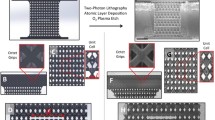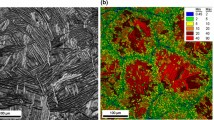Abstract
Designing meta-materials and cellular solids with biomimetic structures has received increasing attention in the past few years partially due to advances in additive manufacturing techniques that have enabled the fabrication of advanced materials with arbitrarily complex microarchitectures and novel functionalities. To impact on this trend, it is essential to develop our understanding about the role of microstructure on mechanical responses of these structures. Although a large literature exists on the general subject, the role of microstructure on the post-yield instability is not yet adequately documented. This research introduces a numerical approach to study the post-yield instability in 2D infinite honeycombs as a bottleneck for understanding the instability in more complex 3D systems. Two distinct algorithms are used to systematically vary the ordering in the microstructure of regular hexagonal honeycombs and the mean cell size in the microstructure of Voronoi honeycombs. Finite elements together with a nonlinear homogenization technique are incorporated to quantify the instability responses. Finally, the contribution of microstructure on initial post-yield instability—the slope and magnitude of stress drop after yielding—is statistically investigated. It is found that changing the degree of ordering in the microstructure with respect to a parent symmetry can systematically vary the post-yield instability properties. However, systematic variation of the cell size distribution in absence of ordering in the microstructure cannot remarkably change the post-yield instability in the meta-material. Instead, a tailored cell size distribution can systematically influence its yield strength and plateau stress.
Similar content being viewed by others
References
Rhee, H., Horstemeyer, M.F., Ramsay, A.: A study on the structure and mechanical behavior of the Dasypus novemcinctus shell. Mater. Sci. Eng. C. 31, 363–369 (2011)
Seki, Y., Schneider, M.S., Meyers, M.A.: Structure and mechanical behavior of a toucan beak. Acta Mater 53, 5281–5296 (2005)
Gibson, L.J.: Inside plants: an engineer’s view of the Arnold Arboretum. Arnoldia 70(2), 13–19 (2012)
Shanks, R.A.: Biomimetic materials: a challenge for nano-scale self-assembly. Express Polym. Lett 8, 543–543 (2014)
Li, J.R., Cheng, H.F., Yu, J.L., Han, F.S.: Effect of dual-size cell mix on the stiffness and strength of open-cell aluminum foams. Mater. Sci. Eng. A. 362, 240–248 (2003)
Ashby, M.F.: The properties of foams and lattices. Phil. Trans. R. Soc. A 364, 15–30 (2006)
Ayyagari, R.S., Vural, M.: On the nature of pressure dependence in foams. Int. J. Solids Struct. 78–79, 160–173 (2016)
Mora, R.J., Waas, A.M.: Evaluation of the micropolar elasticity constants for honeycombs. Acta Mech. 192, 1–16 (2007)
Chung, J., Waas, A.M.: Inplane elastic properties of circular cell and elliptical cell honeycombs. Acta Mech. 144, 29–42 (2000)
Jiménez, F.L., Triantafyllidis, N.: Buckling of rectangular and hexagonal honeycomb under combined axial compression and transverse shear. Int. J. Solids Struct. 50, 3934–3946 (2013)
Sotomayor, O.E., Tippur, H.V.: Role of cell regularity and relative density on elasto-plastic compression response of random honeycombs generated using Voronoi diagrams. Int. J. Solids Struct. 51, 3776–3786 (2014)
Ruan, D., Lu, G., Wang, B., Yu, T.: In-plane dynamic crushing of honeycombs–a finite element study. Int. J. Impact Eng. 28, 161–182 (2003)
Zheng, Z., Yu, J., Li, J.: Dynamic crushing of 2D cellular structures: a finite element study. Int. J. Impact Eng. 32, 650–664 (2005)
Li, K., Gao, X.L., Wang, J.: Dynamic crushing behavior of honeycomb structures with irregular cell shapes and non-uniform cell wall thickness. Int. J. Solids Struct. 44, 5003–5026 (2007)
Papka, S.D., Kyriakides, S.: In-plane compressive responses and crushing of honeycombs. J. Mech. Phys. Solids. 42, 1499–1532 (1994)
Papka, S.D., Kyriakides, S.: In-plane crushing of a polycarbonate honeycomb. Int. J. Solids Struct. 35, 239–267 (1998)
Evans, A.G., Hutchinson, J.W., Ashby, M.F.: Cellular metals. Curr. Opin. Solid State Mater. Sci. 3, 288–303 (1998)
Alkhader, M., Vural, M.: Mechanical response of cellular solids: role of cellular topology and microstructural irregularity. Int. J. Eng. Sci. 46, 1035–1051 (2008)
Hammond, C.: The Basics of Crystallography and Diffraction. Oxford University Press, Oxford (2009)
Dobrin, A.: A Review of Properties and Variations of Voronoi Diagrams. whitman.edu. 1–43 (2005)
Hosseini, S.M.H., Kharaghani, A., Kirsch, C., Gabbert, U.: Numerical simulation of Lamb wave propagation in metallic foam sandwich structures: a parametric study. Compos. Struct. 97, 387–400 (2013)
Jin, T., Zhou, Z., Wang, Z., Wu, G., Shu, X.: Experimental study on the effects of specimen in-plane size on the mechanical behavior of aluminum hexagonal honeycombs. Mater. Sci. Eng. A. 635, 23–35 (2015)
Khadir, Y. K.: Non-linear numerical homogenization: Application to elasto-plastic materials. PhD thesis, Université des Sciences et Technologies de Lille, Laboratoire de Mécanique de Lille (UMR CNRS 8107) (2014)
Walpole, R.E.: Introduction to Statistics. Prentice Hall, Upper Saddle River (1982)
Kenney, J.F., Keeping, E.S.: Mathematics of statistics – §11.4 and 11.5. Van Nostrand, Princeton (1964)
Author information
Authors and Affiliations
Corresponding author
Rights and permissions
About this article
Cite this article
Hosseinabadi, H.G., Bagheri, R. & Altstädt, V. A numerical approach to study the post-yield softening in cellular solids: role of microstructural ordering and cell size distribution. Acta Mech 228, 2005–2016 (2017). https://doi.org/10.1007/s00707-017-1802-y
Received:
Revised:
Published:
Issue Date:
DOI: https://doi.org/10.1007/s00707-017-1802-y




